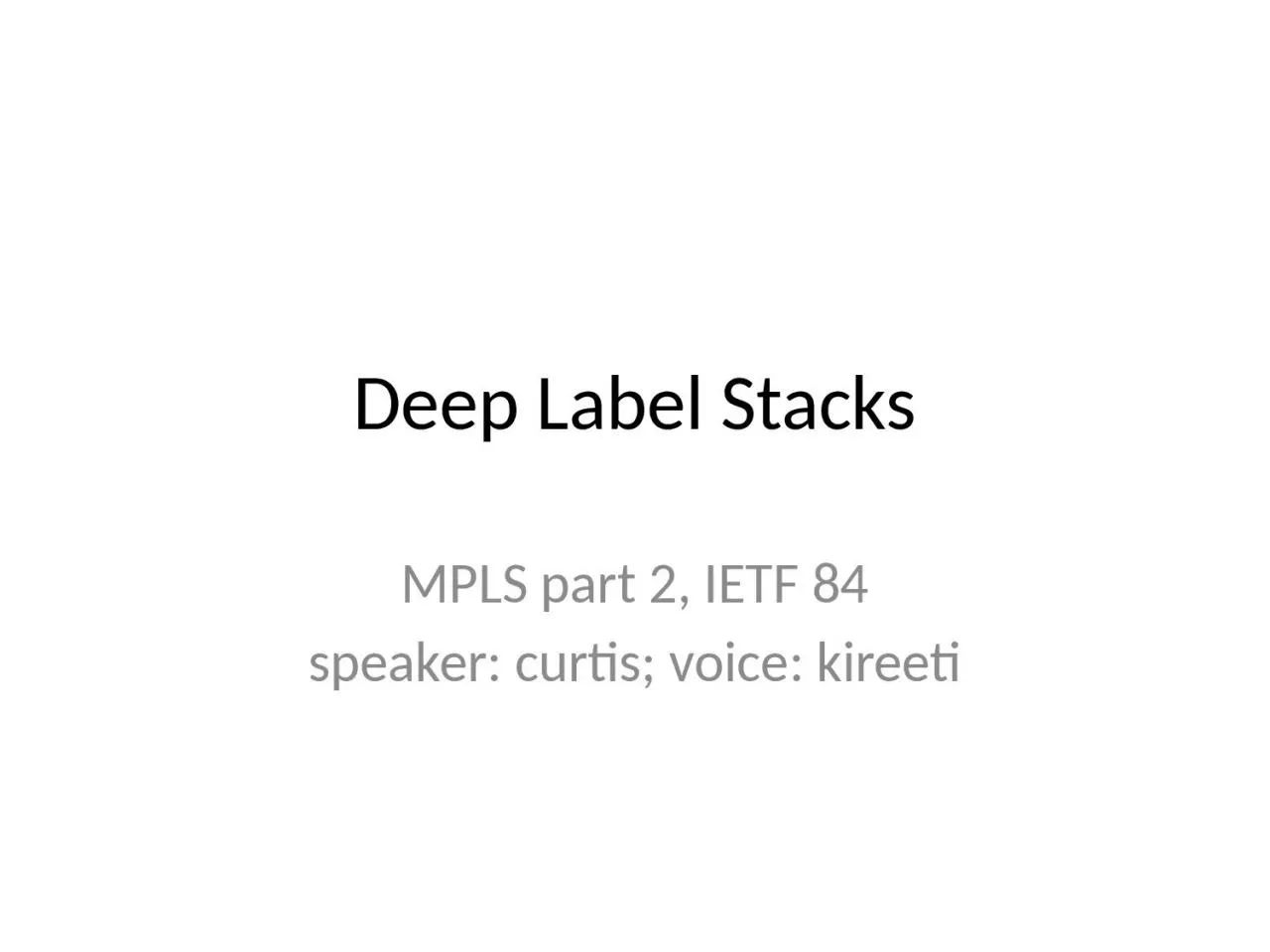

s peaker curtis voice kireeti Deep Label Stacks Curtiss exploration of several forwarding chips led him to think more about the problems that deep label stacks pose to some of the chips ID: 998753
Download Presentation The PPT/PDF document "Deep Label Stacks MPLS part 2, IETF 84" is the property of its rightful owner. Permission is granted to download and print the materials on this web site for personal, non-commercial use only, and to display it on your personal computer provided you do not modify the materials and that you retain all copyright notices contained in the materials. By downloading content from our website, you accept the terms of this agreement.
1. Deep Label StacksMPLS part 2, IETF 84speaker: curtis; voice: kireeti
2. Deep Label StacksCurtis’s exploration of several forwarding chips led him to think more about the problems that deep label stacks pose to some of the chipsThis is to bring the issue to the MPLS WG’s attention, and figure out what (if anything) should be done
3. Connection with Entropy LabelsThe issue is general, and not related to processing entropy labels per se (or load balancing or …)However, ELs contribute to deeper stacksThe entropy label means one more labelELI means yet another labelThe idea of inserting multiple ELs in a label stack further increases the depth
4. Problem 1: deep label operationsUsually, label operations work with just the top label or twoHowever, sometimes many labels have to be pushed/popped/swappedReasonable to limit number of labels that can be processed => potentially expensive ASIC resourcesAs with many such limits (640K anyone?), time overruns the limit
5. PHP vs. UHPPenultimate hop popping (PHP) is a clever way to distribute deep label operations across several boxesHowever, PHP means that the data plane of an LSP stops short of the control planeTheoretical issue: “MPLS architecture is impure”Practical issue: “I need stats!”UHP to get stats means yet more burden to deep label operations: do stats with every pop
6. Exceeding Limit #1What can a chip do if its imposed limit on label depth is exceeded?Take a performance hit (lower pps)Drop “violating” packetsWedge :-)
7. Problem 2: Searching for BoSEven if forwarding decisions require just a few labels, there are times when chips look for the label with the BoS setThis may be to validate the label stackThis may be for load-balancing purposesPick labels near BoS for LB purposesGo beyond label stack for fields for LB
8. Load Balancing and BoSFrom the PoV of load balancing, labels near the BoS are better than labels near the Top of Stackthink pseudowire labels vs. tunnel labelsSometimes even this is not enough, and “good” fields for LB come from the payloadIP fields inside an Ethernet frame in a PWFat PW labels and entropy labels obviate the need for this, but these are recent advances
9. Exceeding Limit #2Again, what does a chip do if it doesn’t find a BoS label in its “window of search”?Discard packet as “malformed”Take a performance hit to search further
10. Addressing the ProblemsChange chip design to focus on theseNeed guidelines on what to watch out forChange deploymentNeed “traps” to realize there’s an issue, and knobs to tweak behaviorLimit stats on a given LSPChange network architectureE.g., add an extra hop to avoid multiple UHPs
11. Okay, So What?Is this a fairly complete list of problems related to depth of stack and BoS?Survey: who has which problem?Should the IETF care? MPLS WG? If so, how:BCP? For what:Chip implementation guidelines?Deployment guidelines?Network architecture guidelines?
12. Next StepWG chairs + ADs need to tell us whether and how to proceed, starting with how much of this in the IETF scope and in the WG scopeDoing a survey might be helpful to evaluate the depth, urm, extent of the problemLogistics may be tricky (NDA, etc.)